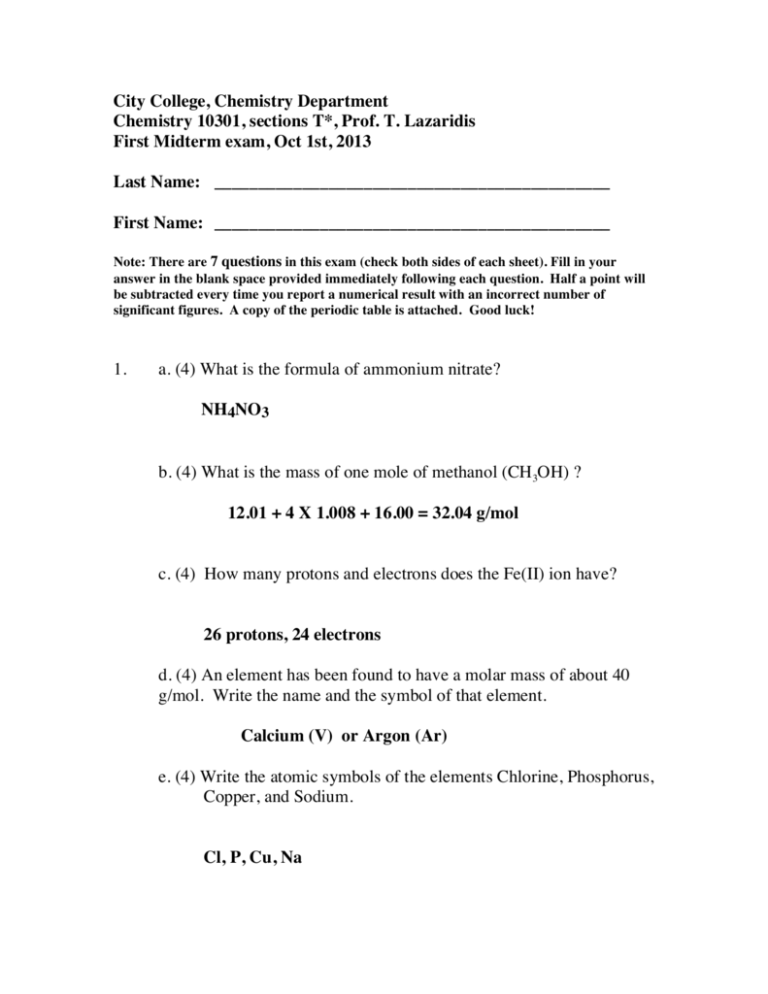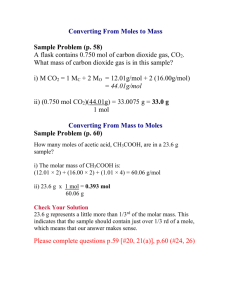First exam 2013 with answers
advertisement

City College, Chemistry Department Chemistry 10301, sections T*, Prof. T. Lazaridis First Midterm exam, Oct 1st, 2013 Last Name: _____________________________________________ First Name: _____________________________________________ Note: There are 7 questions in this exam (check both sides of each sheet). Fill in your answer in the blank space provided immediately following each question. Half a point will be subtracted every time you report a numerical result with an incorrect number of significant figures. A copy of the periodic table is attached. Good luck! 1. a. (4) What is the formula of ammonium nitrate? NH4NO3 b. (4) What is the mass of one mole of methanol (CH3OH) ? 12.01 + 4 X 1.008 + 16.00 = 32.04 g/mol c. (4) How many protons and electrons does the Fe(II) ion have? 26 protons, 24 electrons d. (4) An element has been found to have a molar mass of about 40 g/mol. Write the name and the symbol of that element. Calcium (V) or Argon (Ar) e. (4) Write the atomic symbols of the elements Chlorine, Phosphorus, Copper, and Sodium. Cl, P, Cu, Na 2. Write a balanced equation for each of the following reactions (it is not necessary to indicate the states of each substance): a. (6) Burning of benzene (C6H6) in excess oxygen 2 C6H6 + 15 O2 ------> 12 CO2 + 6 H2O b. (6) Reaction of iron(III) oxide with carbon monoxide to give iron metal and carbon dioxide. Fe2O3 + 3 CO --------> 2Fe + 3CO2 c. (6) Potassium dissolves in water to give potassium hydroxide and hydrogen gas. 2K + 2H2O ---------> 2KOH + H2 d. (6) Nitrogen gas and hydrogen gas react to form ammonia (NH3). N2 + 3H2 ---------> 2NH3 3. (10) A substance that contains C, H, and O is subjected to combustion analysis. 50.0 g of the substance is burned to produce 61.4 g of carbon dioxide and 22.6 g of water. What is the percent composition of this substance? Molar mass of CO2 : 12.01 + 2 X 16.00 = 44.01 g/mol Molar mass of H2O : 16.00 + 2 X 1.008 = 18.02 g/mol 61.4 g CO2 X (12.01 g C)/(44.01 g CO2) = 16.8 g C 22.6 g H2O X (2.016 g H)/(18.02 g H2O) = 2.53 g H Oxygen : 50.0 - 16.8 -2.53 = 30.7 g O Percent composition: C : 16.8/50.0 X 100% = 33.6 % H : 2.53/50.0 X 100% = 5.06 % O : 30.7/50.0 X 100% = 61.4 % 4. The percent composition of glucose is 40.0 % C, 6.7 % H, and 53.3 % O. a. (10) What is the empirical formula of glucose? Consider 100 g of sample. In this we have 40.0 g C, 6.7 g H, and 53.3 g O Find number of moles: C: 40.0 g /(12.01 g/mol) = 3.33 mol H: 6.7 g / (1.008 g/mol) = 6.65 mol O: 53.3 g/ (16.00 g/mol) = 3.33 mol Divide by the smallest: The whole-number ratio is C:H:O = 1:2:1 Therefore empirical formula is CH2O b. (5) The molar mass of glucose is 180.16 g/mol. What is its molecular formula? Molar mass of CH2O unit is 12.01 + 2 X 1.008 + 16.00 = 30.03 g/mol 180.16/30.03 = 6 Therefore, molecular formula is C6H12O6 5. (10) You are given a sample of metal A and a sample of metal B of equal masses. A has a density of 3.2 g/mL and B has a density of 9.6 g/mL. If the sample of metal A has a volume of 7.5 mL, what is the volume of the sample of metal B? mass = density X volume = 3.2 g/mL X 7.5 mL Volume of B = mass/density = 3.2 X 7.5 g / (9.6 g/mL) = 2.5 mL 6. (16) Sodium silicate reacts with hydrofluoric acid in the following way: Na2SiO3 (s) + 8HF (aq) --------> H2SiF6 (aq) + 2NaF (aq) + 3H2O (l) a. (5) A reacting mixture contains 3.0 moles of HF and 2.0 moles of Na2SiO3. Which one is the limiting reactant? 2 moles Na2SiO3 require 16 moles HF. We only have 3 moles of HF. Therefore: HF is the limiting reactant b. (11) How many grams of NaF will be produced by the above reacting mixture? All of HF will react. Molar mass of NaF : 22.99 + 19.00 = 41.99 g/mol 2 moles NaF 41.99g NaF 3.0 moles HF X 8 moles HF X mole NaF = 31 g NaF 7. (5) How many grams of glucose do you need to dissolve in 100 mL of water to make a solution of molarity 3.00 M? The molar mass of glucose is 180.2 g/mol. 3.00 mol/L X 0.100 L X 180.2 g/mol = 54.1 g







